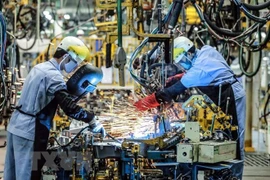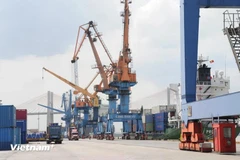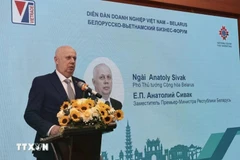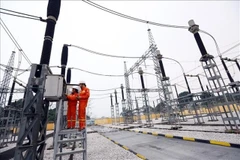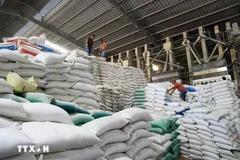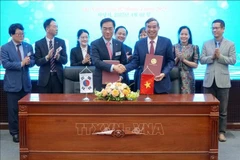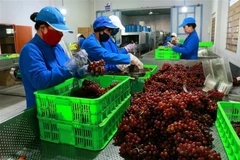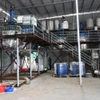
Vietnam’s economic growth in 2016-2020 has improved but not yet met the set strategic target (Photo: VNA)
Hanoi (VNA) - In the 2016-2020, Vietnam’s economic growth has improved and gradually recovered compared to the 2000-2010 period but still has yet to reach the strategic target, according to economist Nguyen Dinh Cung.
Cung, who is former Director of the Central Institute for Economic Management (CIEM), made the remark at a workshop in Hanoi to announce the institute’s report reviewing the outcomes of restructuring the economy and reforming the growth model in 2016-2020. The event was within the framework of the Australia Supports Economic Reform in Vietnam (Aus4Reform) programme.
The report looked at macro economic stability and the economy’s resilience, growth and growth quality, and restructuring of investment, credit organisations and State-owned enterprises.
Cung noted that during 2011-2015, Vietnam began to adjust its policies in the direction of promoting economic restructuring and changing the growth model for rapid and sustainable growth.
Accordingly, macro policies were gradually tightened with flexible adjustment to stabilize the macro economy, while a series of pgorammes and projects were carried out to shift the growth model towards higher quality, greater efficiency and better competitiveness.
“Rigid” economic structure
At present, GDP per capita growth stands at nearly 6 percent, far below the level that can be narrowed and catch up with high-income countries, Cung said.
The Prime Minister has issued Decision 339/QD-TTg approving the Master Plan on economic restructuring in association with conversion of the growth model towards improving quality, efficiency and competitiveness during the 2013-2020 period.
The 12th Party Congress continued to affirm the policy of maintaining macroeconomic stability, strengthening the national economy's resilience, promoting economic restructuring in association with growth model renovation.
As a result, the country’s macro-economy has recorded positive achievements.
GDP per capita in the 2011-2018 period
Under the report, GDP per capita in 2018 reached 58.5 million VND, 1.85 times higher than the figure reported in 2011.
In addition, the average GDP growth rate in the 2016-2018 period was 0.8 percent higher than that in the 2011–2015 period. Of which, the growth of the service and industry-construction sectors was higher than 0.47 percentage points and 0.92 percentage points, respectively, but that of the agro-forestry-fishery sector decreased by 0.45 percentage points.
The report said nine out of 23 sectors made higher contributions to the nation’s economic growth in 2018 compared to 2011. Notably, the processing and manufacturing industry contributed 2.26 percentage points.
Cung said if the mining industry retains the same growth rate as in the previous period, the annual GDP growth is likely to reach over 7 percent.
After the failure of a number of corporations, administrative interventions in the operation of State-owned enterprises have increased, narrowing the autonomy of these enterprises, leading to less effective business, he said, stressing that the Government needs to devise policies in order to early change this situation in the coming time.
It is necessary to not only adjust rules of governance, but also pay attention to divestment activities, he noted.
Ensuring basic rights of investors and entrepreneurs
Basically, Vietnam’s economic growth process has not changed, mainly depending on increasing investment capital, using low-cost labour, labour-intensive economic activities, exports and foreign investment attraction.
The direct cause of the above-mentioned weaknesses and failure is that the institutional reform, resources allocation and economic restructuring programmes have not been conducted consistently and comprehensively, experts said.
A series of proper reform guidelines and policies in the Party's Resolutions have not been realised, they said, stressing that it is necessary to continuously implement three strategic breakthroughs, especially promotion of socialist-oriented market economy institution; and mobilisation, distribution and use of social resources.
 The workshop to announce the CIEM’s report reviewing the outcomes of restructuring the economy and reforming the growth model in 2016-2020 (Photo: VietnamPlus).
The workshop to announce the CIEM’s report reviewing the outcomes of restructuring the economy and reforming the growth model in 2016-2020 (Photo: VietnamPlus).
Participants proposed orientations to overcome imbalances of the economy, especially solutions to ease the economy’s dependence on foreign investment, and to develop the private economic sector at a faster pace than at present.
State-owned enterprises need to be more autonomous and dynamic in accordance with market rules, towards using resources effectively, increasing competitiveness in the international market, and making adequate contributions to the country’s development, experts said.
They added that it is necessary to increase connection among economic sectors, focusing on ensuring basic rights of investors and entrepreneurs.
Cung underlined the leading role played by the State in creating a dynamic economic, saying that the State needs to create opportunities for developing new products and technologies, and business models./.


